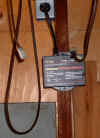|
Here's a piece
about another thing I've been doing for so long I never gave it a second
thought.
 |
You get all kinds of input about battery chargers for home/hobby
use, but all the average guy needs is something similar to the
photo to the left.
The "10/2 AMP" printed on
the side of the charger means it will charge a 12 volt battery
at 10 amps per hour or 2 amps per hour, this one will also
charge at 6 volts. Something in this general range is ideal, but
you can't see the most important feature of this charger. That
feature is in the word "Automatic" that is
printed on the front.
"Automatic" means the
charger will not overcharge your battery no matter how you set
it. When the battery becomes fully charged the unit cuts itself
back to barely a trickle. You can't renew a bad battery with any
charger, but you can kick up a rundown one in about 15 minutes
with one of these. Say you get in, hit the starter and get only
a grunt. Fifteen minutes at the 10 amp setting and you usually
have the hooch to start the car and let the alternator take it
from there.
You should be able to pick up one for
somewhere in the $40.00 range or less. |
 |
Another convenience of a small charger like this is that it is
so adaptable - literally - and you don't need big fat cables to
do it. See that light blue block with the + and -- posts, cord,
and small plug? I use that to adapt to the cigarette lighter
plug and charge the battery in my MGB hassle free (more on that
later).
The lighter plug adapter can be used another
way; and the rig with the alligator clips is for that also (coming
right up). The plugs are keyed to work only one way, so once you
have everything made correctly you can't screw up a
hook-up. They are Radio Shack P/N 274-222 with the
locking tabs cut off.
The
alligator patch cord allows me to attach my battery maintainer
to any 12 volt battery. |
 |
This is the set up I use to charge the battery in my MGB; it can
be used on any car.
Contrary to the photo, I always set the
charger outside the car and a foot or two away from it. Hook
everything up then plug in the charger. No chance for making a
spark in the car that way, and remember to unplug the charger
before disconnecting anything.
You can charge 10 or 12 amps through the
lighter socket with no problems at all, but I wouldn't go any
higher than 12.
The bottom of the plastic block, (wood will
do just as well) is counter bored, the bolt heads sunk into it,
and the holes filled with a non conductive filler to insulate
the bolt heads.
The gizmo beside the charger is a digital
volt meter that plugs into the cigarette lighter socket. I
always carry it in the car to get a quick check, to the tenth of
a volt, on the condition of my battery and charging system in a
jiffy.
Similar more compact units are available at
Auto Zone and other stores for about 10 or 12 bucks. |
 |
This is the battery maintainer I use during those long, cold winter
months. It's intended to be vehicle mounted, but that wasn't
versatile enough to suit me.
I added about 12 feet of lamp cord so it
would reach anything I wanted to in my small garage. I chose lamp
cord because it's very flexible at any temperature and plenty
big enough to handle the 1-1/2 amps of maintainer output. You
get it wired right one time with the keyed Radio Shack 274-222
plugs and you can't hook up wrong after that; so color coding
doesn't matter.
I use the straight cord, lighter plug,
and alligator clip patch cords (shown in a photo above) with
this rig. This one is from NAPA, but it is made by Excide and
may be sold under any number of brand names.
It's not for charging up a dead battery, but
will do it in time. It's real purpose is to maintain a charge in
a charged battery over an indefinite period of time. It has an
indicator light that when showing steadily means it is charging
full tilt, blinking means the battery is nearly at full
capacity, light off shows the battery is at full charge and the
unit has turned itself off.
I bought this one when they were first
introduced for about $35.00, I think the price is down a little
from that now. |
 |
Here is another reason for all the patch cords and adapters.
Notice the plug dead center in this shot of my '93 BMW R100R
scooter which shares garage space with my "78 MGB
"Bea".
I use the maintainer alternately between the
two of them. I can also jam a quick charge into the Beemer and
crank her up should I forget the maintainer for too long in winter. |
So there it is boys & girls. With a little imagination you can
easily rig, charge, and maintain the battery in any vehicle you
have; car, truck, tractor, motorcycle, airplane, motorboat, ATV, you
name it. And you can do it "on the cheap" with only one or
two small chargers. Now,
if you want to know more about your car's battery, jump to my new tech
tip "Batteries
101".
|